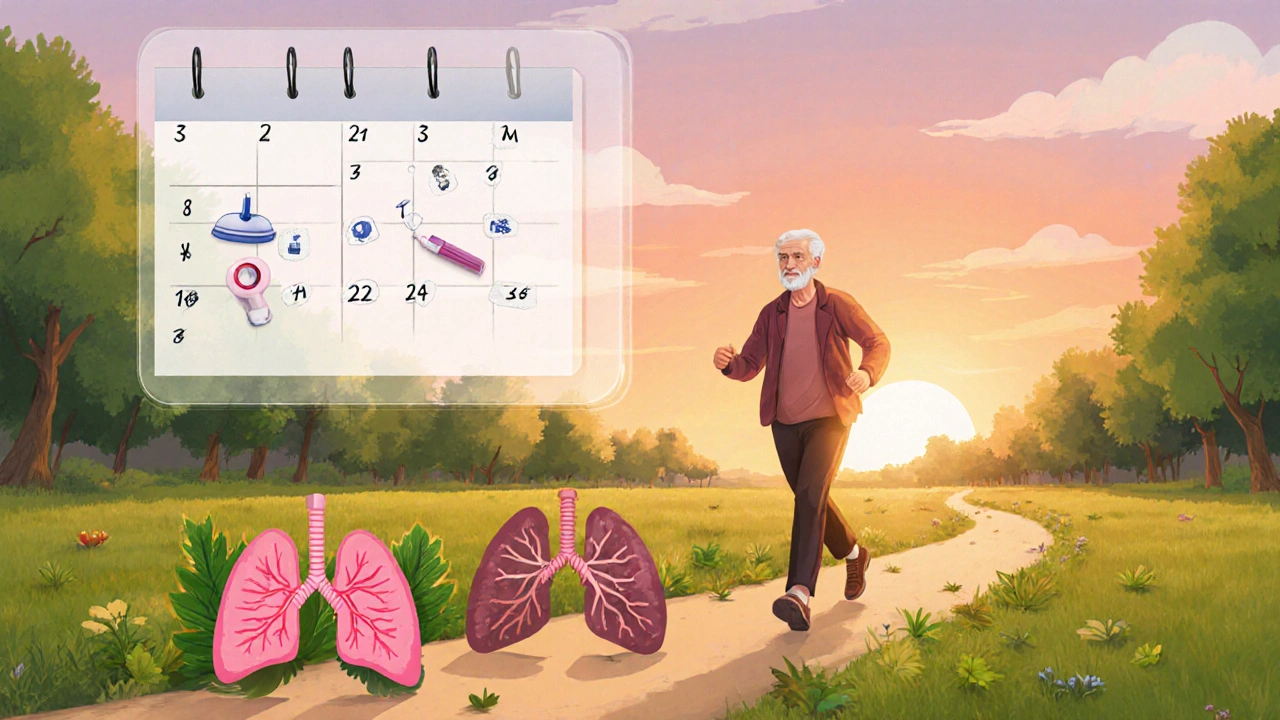Obstructive Pulmonary Disease Check-up Frequency Calculator
Select your current risk level to see recommended check-up frequency and key tests for your condition.
Low Risk
Stable FEV1 > 70% predicted, no recent exacerbations
Moderate Risk
FEV1 50-70%, one exacerbation in past year
High Risk
FEV1 < 50%, two or more exacerbations in past year
Check-up Frequency Recommendations
Based on your selected risk level, here's what you should expect during your visits:
Please select a risk level to see your personalized check-up recommendations.
Suggested Check-up Frequency by Risk Level
| Risk Level | Typical Indicators | Recommended Visit Frequency | Key Tests at Each Visit |
|---|---|---|---|
| Low | Stable FEV1 > 70% predicted, no recent exacerbations | Every 12 months | Spirometry, symptom review, inhaler check |
| Moderate | FEV1 50-70%, one exacerbation in past year | Every 6 months | Spirometry, chest X-ray, vaccination review |
| High | FEV1 < 50%, two or more exacerbations in past year | Every 3 months | Spirometry, chest CT, medication review, lifestyle counseling |
Understanding how obstructive pulmonary disease progresses is key to staying ahead of symptoms, and regular check-ups are the main tool that makes it possible.
What regular check-ups actually involve
When doctors talk about a "check-up" for Obstructive Pulmonary Disease, they aren’t referring to a quick blood pressure reading. A comprehensive visit usually includes several distinct components, each aimed at catching a problem before it turns into an emergency.
- Spirometry - a breathing test that measures airflow and lung volume.
- Chest imaging (often a low‑dose X‑ray or CT scan) to spot structural changes.
- Symptom review - a detailed conversation about cough, sputum, breathlessness and fatigue.
- Medication assessment - checking inhaler technique, dosage, and side‑effects.
- Vaccination status - flu and pneumococcal vaccines are especially important.
- Lifestyle counseling - smoking cessation, nutrition, and activity planning.
Why timing matters: Frequency recommendations
The risk of an exacerbation (a sudden worsening of symptoms) climbs sharply when check-ups are spaced too far apart. Recent data from a 2024 multinational cohort show that patients who visited their clinician at least twice a year experienced 30% fewer hospital admissions than those who came only once or less.
| Risk Level | Typical Indicators | Recommended Visit Frequency | Key Tests at Each Visit |
|---|---|---|---|
| Low | Stable FEV1>70% predicted, no recent exacerbations | Every 12months | Spirometry, symptom review, inhaler check |
| Moderate | FEV1 50‑70%, one exacerbation in past year | Every 6months | Spirometry, chest X‑ray, vaccination review |
| High | FEV1<50%, two or more exacerbations, comorbidities | Every 3‑4months | Full panel: spirometry, CT scan if indicated, rehab referral |
How each component helps prevent complications
Spirometry is the gold‑standard for tracking lung function. A drop of 10% in FEV1 over six months often signals an invisible flare‑up that a patient may not yet feel. By catching this early, a clinician can adjust inhaler dosage before a full‑blown exacerbation forces an ER visit.
Imaging, especially low‑dose CT, reveals emphysema progression or the emergence of lung infections that plain X‑rays miss. Spotting a new infiltrate early allows targeted antibiotics, which are far more effective when started promptly.
Medication assessments go beyond checking that the inhaler is in the fridge. Poor technique - like not holding the breath for the recommended 5‑10 seconds - can cut drug delivery by half. Re‑training patients during each visit maintains therapeutic potency.
Vaccinations act as a safety net. Flu season spikes COPD hospitalizations by up to 40%. Ensuring patients receive the latest flu and pneumococcal shots cuts that risk dramatically.
Lastly, lifestyle counseling, particularly smoking cessation, has the biggest numerical impact. A 2023 meta‑analysis found that quitting smoking reduces the annual decline in FEV1 by roughly 35%, translating into years of added quality‑adjusted life.

Who should drive the check‑up schedule
The Primary Care Physician (PCP) usually coordinates the overall plan. However, specialists such as a Pulmonologist or a rehab therapist become essential when risk climbs.
A practical rule of thumb: if a patient reports any increase in daily dyspnea, new sputum color, or a missed dose of inhaler, schedule an extra visit within two weeks. Early intervention often prevents the need for oral steroids, which carry their own set of side‑effects.
Common pitfalls and how to avoid them
- Skipping the spirometry trend line. Some clinics only look at the latest value. Insist on a graph that shows change over time.
- Assuming stable disease means no rehab. Even patients at low risk benefit from Pulmonary Rehabilitation. Exercise improves muscle efficiency, which reduces breathlessness during everyday tasks.
- Ignoring comorbidities. Heart disease, diabetes, and anxiety amplify COPD symptoms. A holistic review each visit catches overlapping medication issues.
- Relying solely on patient‑reported symptoms. Objective tests (spirometry, imaging) uncover silent declines that a patient may attribute to “just getting older.”
Real‑world example: Jane’s story
Jane, a 62‑year‑old former smoker, was diagnosed with moderate COPD in 2019. Her initial plan called for annual visits. By 2022 she had two ER trips because her lung function slipped unnoticed between appointments.
After her physician switched her to a six‑month schedule and added a quarterly Spirometry check, Jane’s FEV1 stayed within a 5% band, and she hasn’t needed an ER visit since.
The turning point was a simple “how many days this month did you use your rescue inhaler?” question that triggered a medication tweak and a refresher on inhaler technique. Jane’s experience illustrates how structured, regular monitoring can turn a wandering disease into a manageable condition.
Bottom line: Turn check‑ups into a habit, not a hassle
Regular visits are more than a formality; they are the proactive engine that keeps lung decline slow, reduces hospital stays, and preserves independence. By integrating spirometry, imaging, medication reviews, vaccinations, and lifestyle counseling into each appointment, patients and providers create a safety net that catches trouble early.
If you or a loved one lives with obstructive pulmonary disease, ask your clinician to set a clear calendar and stick to it. The time you invest now pays off in fewer flare‑ups, lower medication costs, and a better quality of life.

Frequently Asked Questions
How often should I get a spirometry test?
For most patients with stable disease, every 6‑12months is sufficient. If you’ve had an exacerbation or a change in symptoms, a test within the next 4‑6weeks is advisable.
Can I skip a check‑up if I feel fine?
Feeling fine doesn’t guarantee that your lungs are stable. Early declines are often silent, so regular appointments are the best way to verify that nothing is slipping under the radar.
What should I bring to my COPD appointment?
Bring a list of current medications (including over‑the‑counter), recent symptom diary entries, any recent test results, and questions about inhaler technique or lifestyle changes.
Is pulmonary rehabilitation necessary for mild COPD?
Yes. Even mild disease benefits from supervised exercise and breathing training, which improve endurance and reduce the chance of future exacerbations.
How do vaccinations fit into my check‑up plan?
Your doctor should verify that you’ve received the annual flu shot and the pneumococcal vaccine series. These protect against infections that can trigger severe COPD flare‑ups.


Michelle Dela Merced
October 4, 2025 AT 17:27🔥💥 Wow, reading this felt like getting a front‑row seat to a life‑saving drama! Regular check‑ups for COPD aren't just a recommendation – they're the epic climax where we finally catch those sneaky exacerbations before they steal the show. 🌬️💨 If you skip them, it’s like walking onto a stage with no script – chaos! 🙈 So, grab that appointment, get your spirometry, and let the doctors be the directors of your breath. 🎭💉
Alex Iosa
October 6, 2025 AT 11:07While the emotive appeal is noted, the underlying data reveal a systematic suppression of vital health information by pharmaceutical conglomerates. The frequency recommendations are calibrated to maximize medication turnover, not patient outcomes. It is incumbent upon us to scrutinize the sources of these guidelines and advocate for transparent, independent research.
melissa hird
October 8, 2025 AT 04:47Indeed, the purported "clinical necessity" of quarterly CT scans for high‑risk patients reads like a melodramatic script penned by radiology departments seeking applause. One might question whether such frequency is driven by evidence or an overzealous desire to justify expensive equipment. Nonetheless, the table presented does outline a reasonable framework, albeit drenched in bureaucratic flourish.
Mark Conner
October 9, 2025 AT 22:27Yo, this is straight up American health iron‑y. We brag about freedom but then let folks with real breathing problems wait months for a check‑up. If you love your country, you push for more accessible pulmonology clinics. No more bureaucratic hoops – just get the lungs checked, period.
Charu Gupta
October 11, 2025 AT 16:07It is paramount to note that the language employed in the article adheres to standard grammatical conventions, yet there exists a subtle lapse in the use of the serial Oxford comma within the bullet list. Correcting this would enhance clarity. Additionally, while emojis are permissible in informal discourse, their omission here maintains professional decorum. 📚
Abraham Gayah
October 13, 2025 AT 09:47Honestly, the whole “every 3 months for high risk” thing sounds like a plot twist nobody asked for. Who has time for quarterly visits when you’re juggling work, life, and the endless stream of Netflix? It’s just another way the health industry keeps us glued to appointments. 🙄
rajendra kanoujiya
October 15, 2025 AT 03:27Not to be a buzzkill, but why trust any of these guidelines? Most of the research is funded by the very companies that sell inhalers. We should question the motives behind the suggested frequencies.
Caley Ross
October 16, 2025 AT 21:07Just a heads‑up: if you’re low risk, an annual check‑up is usually enough. But keep an eye on any new symptoms – sometimes they creep up slowly.
Becky Jarboe
October 18, 2025 AT 14:47From a pulmonary physiology standpoint, the periodic assessment of FEV1 trends is essential for prognostic modeling. Regular spirometric data points enable clinicians to calibrate therapeutic regimens with greater precision, thereby attenuating the risk of acute exacerbations. Moreover, integrating longitudinal imaging biomarkers can further refine phenotypic stratification.
Carl Boel
October 20, 2025 AT 08:27The data-driven approach you outlined dovetails with current guideline consensus, reinforcing the necessity for tiered visit intervals. High‑risk patients, in particular, benefit from intensified surveillance to preempt respiratory decompensation.
Shuvam Roy
October 22, 2025 AT 02:07Thank you for sharing this comprehensive overview. It is encouraging to see emphasis on vaccination status, as influenza and pneumococcal immunizations play a pivotal role in reducing infection‑related exacerbations. I would also recommend discussing pulmonary rehabilitation programs during visits, as they have demonstrated improvements in functional capacity.
Jane Grimm
October 23, 2025 AT 19:47While the article is informative, it glosses over the fact that many patients cannot afford the recommended frequency of imaging studies. The financial burden is a serious barrier that warrants acknowledgment.
Nora Russell
October 25, 2025 AT 13:27The tabular presentation is aesthetically pleasing, but the substantive content is shallow. A more rigorous analysis of outcome metrics would elevate this from a superficial summary to a valuable clinical resource.
Susan Rose
October 27, 2025 AT 06:07Great info! I think it’s super helpful for anyone trying to stay on top of their lung health.
Brian Lancaster-Mayzure
October 28, 2025 AT 23:47Let me break down why these check‑ups matter in plain English, even though the science can get pretty technical.
First, regular spirometry gives us a baseline, so any drop in FEV1 is caught early before you feel out of breath doing everyday chores.
Second, imaging isn’t just for fancy doctors – a low‑dose CT can spot early emphysema changes that a standard X‑ray might miss.
Third, reviewing your inhaler technique each visit can prevent misuse, which is a common reason for sudden flare‑ups.
Fourth, vaccinations are a cornerstone; flu and pneumonia shots dramatically reduce infection‑triggered exacerbations, which are a leading cause of hospital stays.
Fifth, lifestyle counseling, especially smoking cessation, has the biggest impact on long‑term survival – quitting even a few cigarettes a day can improve lung function over time.
Sixth, symptom diaries help clinicians differentiate between chronic cough and an acute exacerbation, allowing for timely intervention.
Seventh, medication reviews ensure you’re not taking redundant steroids, which can have nasty side effects.
Eighth, a multidisciplinary approach involving physiotherapists can improve exercise tolerance and quality of life.
Ninth, frequent visits for high‑risk patients (every three months) have been linked to a 30% reduction in emergency department visits, according to recent studies.
Tenth, these appointments also provide an opportunity to discuss advanced care planning, which is often overlooked until it’s too late.
Eleventh, regular monitoring fosters a therapeutic alliance, making patients more likely to adhere to treatment plans.
Twelfth, data from electronic health records show that patients who stick to the recommended schedule have slower disease progression.
Thirteenth, early detection of comorbidities like heart failure can be life‑saving, as COPD often masks cardiac symptoms.
Fourteenth, the psychological benefit of feeling “seen” by a healthcare team cannot be overstated; it reduces anxiety and depression associated with chronic illness.
Fifteenth, finally, staying on top of these check‑ups empowers you to take control of your health rather than reacting to crises.
In short, think of each appointment as a checkpoint in a marathon – it keeps you on pace, prevents unexpected hurdles, and gets you across the finish line with your lungs intact.
Steve Kazandjian
October 30, 2025 AT 17:27Thanks for the detailed breakdown. It really helps to see how each part fits into overall care.
Roger Münger
November 1, 2025 AT 11:07The article correctly emphasizes that consistent monitoring aligns with evidence‑based practice, thereby optimizing therapeutic outcomes.
Gerald Bangero
November 3, 2025 AT 04:47Staying proactive with these appointments is like planting seeds for healthier lungs; each visit nurtures growth and prevents the weeds of exacerbation from taking over.
John Nix
November 4, 2025 AT 22:27Maintaining professional boundaries ensures that patient autonomy remains paramount.